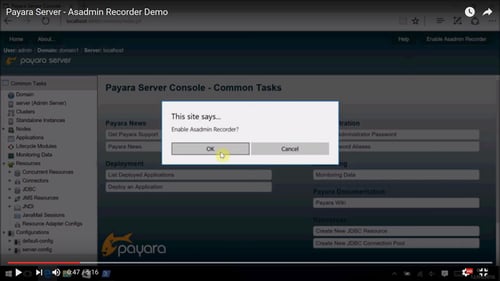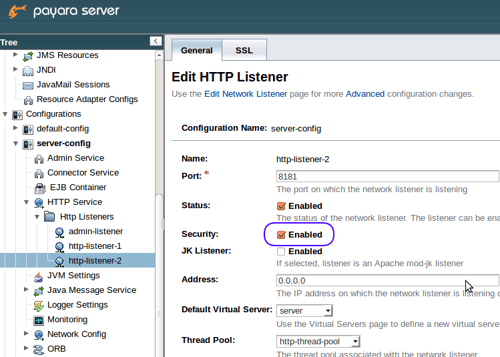Posts tagged How-to (8)
JSF 2.3 - The WebSocket Quickstart under Payara Server
Published on 17 May 2016
by Dominika Tasarz
Topics:
Java EE,
How-to
|
4 Comments
Guest blog by Anghel Leonard ( @anghelleonard ).
Starting with JSF 2.3-m05 we can take advantage of a brand new feature - register a WebSocket push connection in client side. Thanks to the JSF team (especially to Bauke Scholtz (aka BalusC)) this feature is available in today milestone via <f:websocket/> tag.
In this post, let's see a minimal usage of <f:websocket/> tag.
Asadmin Recorder - New Payara Server Feature Demo
Published on 13 May 2016
by Andrew Pielage
Topics:
What's New,
Ops Teams,
How-to,
Admin,
DevOps
|
4 Comments
One of the most exciting new features in the Payara Server 162 release is the Asadmin Recorder - a tool especially useful for the Operations Teams!
Asadmin Recorder allows you to create runnable scripts of asadmin commands that mirror configuration done in the administration console. Have a look at our video walkthrough below for a quick overview of this new Payara Server feature.
Running Payara Server on the Zulu JVM
Published on 28 Apr 2016
by Susan Rai
Topics:
Payara Server Basics,
How-to,
GlassFish basics,
JVM
|
0 Comments
Ejecutando Payara Server en una JVM Zulu
Published on 28 Apr 2016
by Susan Rai
Topics:
Payara Server Basics,
How-to,
GlassFish basics,
JVM,
Spanish language
|
0 Comments
Deploying Multiple Application Versions on Payara Server
Published on 13 Apr 2016
by Ondro Mihályi
Topics:
How-to,
Admin
|
1 Comment
Securing Payara Server with Custom SSL Certificate
Published on 08 Apr 2016
by Ondro Mihályi
Topics:
How-to,
Security,
Admin
|
38 Comments
One of the most common administration tasks with Payara Server, as well as with any web server, is to set up certificates to secure either HTTP protocol or remote access to Payara Server administration interface. You might have a self-signed certificate or a certificate signed by a trusted authority. In both cases it is pretty easy to add them to a Payara Server domain and use them to secure communication channels.
How to use the OpenMQ Broker separately to Payara Server
Published on 30 Mar 2016
by Ondro Mihályi
Topics:
OpenMQ,
How-to
|
2 Comments
Payara Server comes bundled with OpenMQ, which implements the Java Message Service (JMS) standard.
For simple messaging scenarios, it is convenient to use embedded OpenMQ broker, which is available by default. However, this embedded OpenMQ is running inside the JVM instance of Payara Server. This implies that whenever one of them needs to be restarted, the other one gets restarted too.
Troubleshooting your Java EE Applications
Published on 22 Mar 2016
by Mike Croft
Topics:
Java EE,
Ops Teams,
How-to,
Healthcheck,
Payara Server 5
|
0 Comments
Crear un Servicio Web RestFul con Payara Server y NetBeans
Published on 17 Mar 2016
by Steve Millidge
Topics:
Payara Server Basics,
How-to,
NetBeans,
Spanish language
|
0 Comments
Payara Server y NetBeans son perfectos para crear servicios web RESTFul y aplicaciones web!
See here for the original version in English language.
En este corto video, voy a mostraros como de fácil es crear un servicio web RESTFul utilizando Payara Server con NetBeans.
Create a RESTful Web Service with Payara Server & NetBeans
Published on 17 Mar 2016
by Steve Millidge
Topics:
Payara Server Basics,
How-to,
NetBeans
|
3 Comments









